
Learn how to better manage your dog and its environment to prevent reactive responses
“I don’t think the training is working. My dog still reacts at every dog we see!”
This is actually a common thing for us to hear in our classes and we understand how frustrating it can be for a student. However, it has nothing to do with the actual training and everything with how we are setting our dogs up to fail. Prevention and management is the key to any training program, but it is critical when dealing with fear and/or reactivity concerns. This is because every time you put your dog into a situation where they react, you are continuing their learning that this response works! For example, your dog sees another dog on leash and they react out of fear by lunging and barking. Most owners respond by pulling their dog away or the other dog owner leaves, which in turn teaches our dog that their reactive behaviour works at making scary things go away.
So how do we use prevention and management with reactivity? First off, know how far of a distance your dog needs to be below threshold (can be alert to the trigger but is not reacting). If your dog cannot walk on one side of the street while a dog is on the other side without reacting, you need to start by walking your dog out of your neighbourhood. Some good places to go are large on leash park areas such as Fish Creek Park or Confederation Park. Or to a large green space or parking lot area. The key is that you are in a place where there is enough distance to keep your dog below threshold.
If you are putting your dog into situations where they are continually reacting they are constantly stressed and learning their behaviour works, they will continue to become more reactive despite how much work you are putting into the training. Your dog cannot learn when they are reacting and both of you will be feeing far too frustrated. We get frustrated as we keep putting our dogs into a reactive state and try to get their attention back on us. We need to instead prevent the behaviour from happening (get to more space) and manage the environment to minimize surprise situations that cause your dog to react (open spaces where you can easily see what is coming into the environment).
Prevention and management is about setting both you and your dog up for success. Taking a reactive dog out is stressful, so if you are finding the walks stressful and dread going out, then you need to go to an environment where neither of you feel frustration and stress and you can get working as a team again. Get out and remember how much fun time spent walking with your dog can be. And if you find that your dog is reacting to more things than not, remind yourself that is not the training and you cannot be frustrated at your dog. Instead, ask your dog to forgive you.




